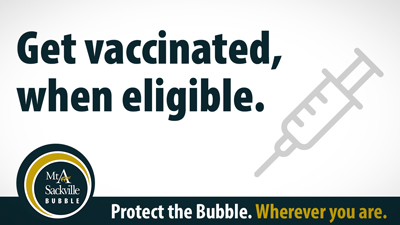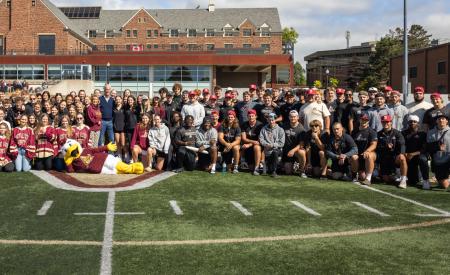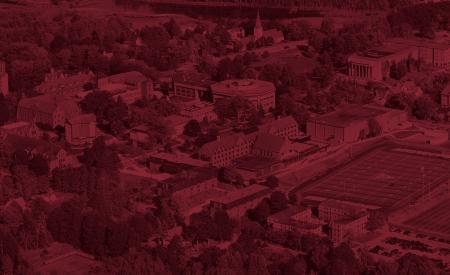The Science of Vaccines
Daily, even hourly, news and updates around the COVID-19 pandemic have become part of our lives over the past year. While news of vaccination development and roll-out is a welcome stage in the pandemic, navigating information and spotting mis-information can be challenging.
Mount Allison Dean of Science and biochemist Dr. Amanda Cockshutt has taught at the University since 1996, including courses in immunology. She is also the founder and past CEO of an international research company whose work focuses on using antibodies, similar to those produced in response to a vaccine, from animals for research purposes.
She recently shared her scientific knowledge around immune response and vaccine development, summarized below.
Immune response overview
When your body, or another organism, is exposed to a pathogen — that’s what causes an infectious disease — it mounts an immune response so that the next time it sees that pathogen, it can get rid of it for the short term. There is a quick reaction, known as the innate immune response. This reaction is usually what makes people feel unwell, like having a sore throat or a fever when you come into contact with the virus that causes strep throat.
Your body also builds up an immunity to the disease so you don’t get as sick the next time the pathogen is encountered, training different cell types to recognize parts of the pathogen so that it can be efficiently eliminated. This ‘memory’ helps train the body cells to recognize what is self and what is non-self (like the pathogens). This recognition allows your body to have an immune response and remember the pathogen, which is what keeps you from getting really sick each time you’re exposed to a pathogen such as a bacteria, virus, or parasite which for most of us is fairly frequently.
How are vaccines made?
Vaccine production is very similar to what I do in my research program and commercialization. I raise antibodies in animals that detect proteins I want to study or that other people want to study. These antibodies are used as diagnostic tools in scientific research, they help us measure a protein in a complex mixture like a whole cell extract.
There are different kinds of vaccines out there, one of the most common forms is when individuals are given an inactivated virus or bacteria that can’t make you sick, but helps your body recognize the pathogen to mount an immune response when exposed to it in the future. This approach has been commonly used in flu shots and other routine vaccinations.
This isn’t what is being used in the COVID-19 vaccines we are seeing produced. COVID-19 vaccines currently have two primary strategies:
- mRNA — mRNAs are working copies of DNA, the genetic material in cells, which go into cells, enabling them to make a protein from the pathogen themselves and help the body start an immune response to it. So, an individual’s own cells are using this working copy to make the protein. The immune system does not recognize the protein as ‘self’ so mounts a response to get rid of the pathogen if the body is exposed in the future. This is the science behind the Moderna and Pfizer vaccines. But, encapsulated RNA is unstable and it breaks down quickly, which is why these vaccines need to be stored at such a low temperature (-80C). This is the first time working copies of mRNA have been used in vaccines globally.
- DNA — This vaccine distribution method puts the DNA for the COVID ‘spike’ protein in the organism, using a viral vector vaccine. This is the scientific method behind the Oxford AstraZeneca and Johnston and Johnston vaccines. The pathogen’s DNA is encoded into the adenovirus, which helps to get the DNA into cells in the body. The adenovirus is used as a transport for the vaccine; certain ones are selected for this ‘delivery job’ because they have been modified so they can’t infect humans. They can cause common cold symptoms but most individuals’ immune systems can manage it and destroy it. The genetic code in the adenovirus transporter tells your body to build the same kind of spike proteins found on the COVID-19 virus, which will enable your body to start building a defense system against the virus. This can’t change your body’s DNA, it’s simply another delivery method that helps your body build immunity against these pathogens. Adenovirus technology is commonly used in gene therapy. This is the first time it’s been used in vaccine development as well.
What should people know as we navigate our second year of the pandemic?
Globally, including in our region, we are now in a race against the COVID variants, which spread more quickly and seem to affect more people more severely. I know there is a lot information out there and this can cause confusion and hesitation, but the more people who get vaccinated, the more we are collectively protected. We’ve seen three known variants reported in our province already this spring.
Vaccination of the vast majority is needed to reach herd immunity. No vaccines are 100% effective, but science shows that the risks of not getting vaccinated are far greater to both personal (most cases) and community health than the risks of getting vaccinated.
Everyone’s situation will be unique, but research shows the chances of getting extremely sick from COVID-19 are far less if you’re vaccinated. Your body is primed and can mount an immune response more quickly, even with just partial vaccination, although full vaccination is needed to be most effective. Everyone, whether they are vaccinated or not, needs to continue to follow Public Health guidelines such as mask-wearing and physical distancing to reduce virus transmission as well.
Personally, I was able to receive my first dose of the AstraZeneca vaccine earlier this spring. I know the first dose does a lot of the job, but it doesn’t do the whole job. It’s important to keep track of when you are eligible and rollout plans for both first and second doses as they become available.
Additional information around New Brunswick’s COVID-19 Vaccine Roll-out
How do I get a vaccine in the MtA Sackville Bubble region?
 Sackville clinics, through the Vitalité Health Network, for those eligible are being held at Tantramar Veterans Memorial Civic Centre this spring and summer, as well as at additional clinics taking place across the province. You must register at https://www.gnb.ca/nosearch/vacc/index-e.html or by calling 1-833-437-1424.
Sackville clinics, through the Vitalité Health Network, for those eligible are being held at Tantramar Veterans Memorial Civic Centre this spring and summer, as well as at additional clinics taking place across the province. You must register at https://www.gnb.ca/nosearch/vacc/index-e.html or by calling 1-833-437-1424.
Vaccines will also be available at local pharmacies for those eligible by appointment. Please contact your pharmacy for more information once you have reviewed the eligibility requirements, which are available at the above link.
Updates on New Brunswick’s vaccination roll-out can also be found at: https://www2.gnb.ca/content/gnb/en/corporate/promo/covid-19/nb-vaccine.html




